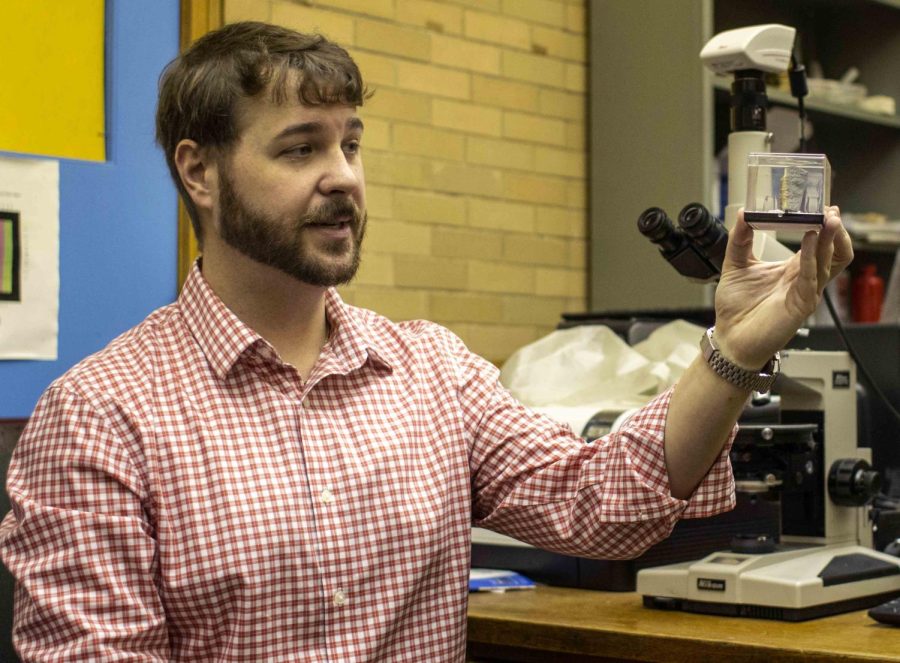Geology, geography professor works for NASA
Jake Crandall, an instructor in the Geology-Geography department and NASA contractor, demonstrates an extinct rock, Komatilte, Sunday afternoon, Jan. 22, 2023, in the Physical Science Building on Eastern Illinois University campus in Charleston, Ill. Crandall said he loves geology, because he can create a historical book dating back billions of years. Komatilte is associated with gold and nickel deposits in Australia, Canada, South Africa, and the Guiana shield, South Africa.
January 25, 2023
Whether it be working on campus or working for NASA, this Eastern professor shows that he can really do it all.
Jake Crandall, a professor from the geology and geography department at Eastern and NASA contractor, said that when it came to working with NASA, he just “kinda fell into it.”
While working on his masters degree, he was working on a project that allows individuals to treat Earth as if it were Mars. This allows them to infer what’s happening in the subsurface area. As more work occurred in the area, more projects kept coming into fruition. Soon, a small project that was working for a PhD became an international project.
“We have people from the [United Kingdom], we have people from Israel, we have folks from Germany…and the Jet Propulsion Laboratory in California,” Crandall said.
From there, this event really took flight. It was first funded by National Geographic before it evolved to a NASA funded project.
From there, they were able to learn that it was a potentially habitable environment. The fluids moving around that sulfur and iron are being mobilized. This means that certain organisms could potentially use those to respirate instead of photosynthesis.
In other words, this means that certain organisms could breathe without using photosynthesis.
So now bares the question, could humans live on Mars?
Sadly, Crandall says that due to radiation and a lack of a magnetic field, it is not possible to do so.
For those who don’t know, radiation for humans is extremely dangerous.
“That magnetic field is what also protects us from a lot of harm from solar radiation and cosmic rays… So Mars’ interior has cooled so much that it’s all solid,” Crandall said. “It doesn’t have convection, and it doesn’t have a magnetic field, so the surface is being irradiated.”
But this is why the Mars rover is so useful too. They work to try and help discover new materials, as well as different compositions of rocks that are harder to find.
Fun fact, because of an accident, these scientists were able to discover the color of zinc. When they accidentally shot the rover with its own laser, it turned white. It showed that there was a high concentration of zinc in the rover’s chemical composition.
“That little accident led to a fantastic discovery about metals that we weren’t sure were doing on the surface and subsurface,” Crandall said.
Crandall’s favorite thing about publishing a new paper is sharing the knowledge with everyone who reads it. Even when the work may seem tedious or daunting, the results are very rewarding.
“Once you’ve sorted out what that will tell you about your project or your study area, especially something that no one has ever looked at before, it’s pretty neat,” Crandall said.
Plus side of his work, there’s always a new study to be discovered. Crandall admits to having a bunch more project ideas in store for the future, which are all divided up into piles of rocks and theories.
As for his favorite mineral, its stibnite, which almost looks like the Iron Throne from Game of Thrones.
Overall, Crandall says that even though this wasn’t the original path he thought life would take him, it’s been the best adventure he could ask for.
“Geology is a lot of fun,” Crandall said. “I just couldn’t think of anything else I’d rather do.”
Adriana Hernandez-Santana can be reached at 581-2812 or at [email protected].




















































